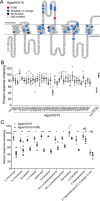Mutant cycle analysis identifies a ligand interaction site in an odorant receptor of the malaria vector Anopheles gambiae
- PMID: 28972152
- PMCID: PMC5704475
- DOI: 10.1074/jbc.M117.810374
Mutant cycle analysis identifies a ligand interaction site in an odorant receptor of the malaria vector Anopheles gambiae
Abstract
Lack of information about the structure of insect odorant receptors (ORs) hinders the development of more effective repellants to control disease-transmitting insects. Mutagenesis and functional analyses using agonists to map the odorant-binding sites of these receptors have been limited because mutations distant from an agonist-binding site can alter agonist sensitivity. Here we use mutant cycle analysis, an approach for exploring the energetics of protein-protein or protein-ligand interactions, with inhibitors, to identify a component of the odorant-binding site of an OR from the malaria vector, Anopheles gambiae The closely related odorant-specificity subunits Agam/Or15 and Agam/Or13 were each co-expressed with Agam/Orco (odorant receptor co-receptor subunit) in Xenopus oocytes and assayed by two-electrode voltage clamp electrophysiology. We identified (-)-fenchone as a competitive inhibitor with different potencies at the two receptors and used this difference to screen a panel of 37 Agam/Or15 mutants, surveying all positions that differ between Agam/Or15 and Agam/Or13 in the transmembrane and extracellular regions, identifying position 195 as a determinant of (-)-fenchone sensitivity. Inhibition by (-)-fenchone and six structurally related inhibitors of Agam/Or15 receptors containing each of four different hydrophobic residues at position 195 served as input data for mutant cycle analysis. Several mutant cycles, calculated from the inhibition of two receptors by each of two ligands, yielded coupling energies of ≥1 kcal/mol, indicating a close, physical interaction between the ligand and residue 195 of Agam/Or15. This approach should be useful in further expanding our knowledge of odorant-binding site structures in ORs of disease vector insects.
Keywords: Xenopus; electrophysiology; insect; olfaction; oocyte; receptor; structure.
© 2017 by The American Society for Biochemistry and Molecular Biology, Inc.
Conflict of interest statement
The authors declare that they have no conflicts of interest with the contents of this article
Figures




Similar articles
-
A determinant of odorant specificity is located at the extracellular loop 2-transmembrane domain 4 interface of an Anopheles gambiae odorant receptor subunit.Chem Senses. 2014 Nov;39(9):761-9. doi: 10.1093/chemse/bju048. Epub 2014 Sep 30. Chem Senses. 2014. PMID: 25270378 Free PMC article.
-
Volatile allosteric antagonists of mosquito odorant receptors inhibit human-host attraction.J Biol Chem. 2021 Jan-Jun;296:100172. doi: 10.1074/jbc.RA120.016557. Epub 2020 Dec 18. J Biol Chem. 2021. PMID: 33298524 Free PMC article.
-
Inhibition of insect olfactory behavior by an airborne antagonist of the insect odorant receptor co-receptor subunit.PLoS One. 2017 May 31;12(5):e0177454. doi: 10.1371/journal.pone.0177454. eCollection 2017. PLoS One. 2017. PMID: 28562598 Free PMC article.
-
Towards an understanding of the structural basis for insect olfaction by odorant receptors.Insect Biochem Mol Biol. 2015 Nov;66:31-41. doi: 10.1016/j.ibmb.2015.09.010. Epub 2015 Sep 28. Insect Biochem Mol Biol. 2015. PMID: 26416146 Review.
-
Olfaction in Anopheles mosquitoes.Chem Senses. 2021 Jan 1;46:bjab021. doi: 10.1093/chemse/bjab021. Chem Senses. 2021. PMID: 33885760 Free PMC article. Review.
Cited by
-
Annotation and Analysis of 3902 Odorant Receptor Protein Sequences from 21 Insect Species Provide Insights into the Evolution of Odorant Receptor Gene Families in Solitary and Social Insects.Genes (Basel). 2022 May 20;13(5):919. doi: 10.3390/genes13050919. Genes (Basel). 2022. PMID: 35627304 Free PMC article.
-
A single point mutation causes one-way alteration of pheromone receptor function in two Heliothis species.iScience. 2021 Aug 16;24(9):102981. doi: 10.1016/j.isci.2021.102981. eCollection 2021 Sep 24. iScience. 2021. PMID: 34485863 Free PMC article.
-
Odorant Receptors and Odorant-Binding Proteins as Insect Pest Control Targets: A Comparative Analysis.Front Physiol. 2018 Aug 24;9:1163. doi: 10.3389/fphys.2018.01163. eCollection 2018. Front Physiol. 2018. PMID: 30197600 Free PMC article. Review.
-
Pheromone Binding Protein EhipPBP1 Is Highly Enriched in the Male Antennae of the Seabuckthorn Carpenterworm and Is Binding to Sex Pheromone Components.Front Physiol. 2018 Apr 27;9:447. doi: 10.3389/fphys.2018.00447. eCollection 2018. Front Physiol. 2018. PMID: 29755369 Free PMC article.
-
Protocol to identify ligands of odorant receptors using two-electrode voltage clamp combined with the Xenopus oocytes heterologous expression system.STAR Protoc. 2022 Mar 15;3(2):101249. doi: 10.1016/j.xpro.2022.101249. eCollection 2022 Jun 17. STAR Protoc. 2022. PMID: 35310077 Free PMC article.
References
-
- Guidobaldi F., May-Concha I. J., and Guerenstein P. G. (2014) Morphology and physiology of the olfactory system of blood-feeding insects. J. Physiol. Paris 108, 96–111 - PubMed
-
- Gibson G., and Torr S. J. (1999) Visual and olfactory responses of haematophagous Diptera to host stimuli. Med. Vet. Entomol. 13, 2–23 - PubMed
-
- Erdelyan C. N., Mahood T. H., Bader T. S., and Whyard S. (2012) Functional validation of the carbon dioxide receptor genes in Aedes aegypti mosquitoes using RNA interference. Insect Mol. Biol. 21, 119–127 - PubMed
Publication types
MeSH terms
Substances
Grants and funding
LinkOut - more resources
Full Text Sources
Other Literature Sources
Miscellaneous

